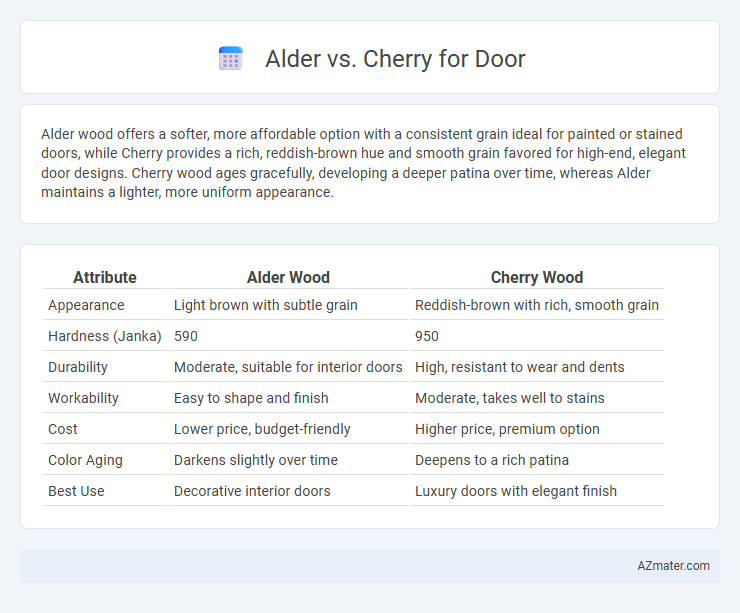Alder wood offers a softer, more affordable option with a consistent grain ideal for painted or stained doors, while Cherry provides a rich, reddish-brown hue and smooth grain favored for high-end, elegant door designs. Cherry wood ages gracefully, developing a deeper patina over time, whereas Alder maintains a lighter, more uniform appearance.
Table of Comparison
| Attribute | Alder Wood | Cherry Wood |
|---|---|---|
| Appearance | Light brown with subtle grain | Reddish-brown with rich, smooth grain |
| Hardness (Janka) | 590 | 950 |
| Durability | Moderate, suitable for interior doors | High, resistant to wear and dents |
| Workability | Easy to shape and finish | Moderate, takes well to stains |
| Cost | Lower price, budget-friendly | Higher price, premium option |
| Color Aging | Darkens slightly over time | Deepens to a rich patina |
| Best Use | Decorative interior doors | Luxury doors with elegant finish |
Introduction to Alder and Cherry Wood
Alder wood, known for its fine grain and uniform texture, offers a smooth, light brown hue that deepens over time, making it popular for interior doors that require a warm, natural look. Cherry wood features rich, reddish tones with a distinctive fine grain that darkens elegantly with age, providing a luxurious, classic appeal in door construction. Both woods balance durability and aesthetic qualities, but cherry tends to be harder and more resistant to dents, while alder is often more affordable and easier to stain.
Key Differences Between Alder and Cherry
Alder wood is softer and more affordable with a uniform texture, making it ideal for budget-friendly door projects, while cherry wood offers a harder, denser composition with a rich reddish-brown color that deepens with age. Alder's grain is straight and less pronounced, providing a smooth, subtle finish, whereas cherry features a distinctive fine grain and natural luster that enhances elegance and durability. The natural resistance to warping in cherry wood surpasses alder, making cherry doors more resilient over time in varying humidity conditions.
Appearance and Grain Patterns
Alder wood features a smooth, consistent grain with subtle knots and a warm, reddish-brown hue that deepens over time, making it ideal for doors with a rustic or traditional aesthetic. Cherry wood displays a richer, more pronounced grain pattern with natural swirls and reddish to deep brown tones that darken elegantly with age, adding sophistication to entrance designs. Both woods offer unique visual textures, but Cherry's distinctive grain complexity provides a more luxurious and refined door appearance compared to Alder's softer, more uniform look.
Durability and Hardness Comparison
Alder wood is softer and less dense than cherry, making it more prone to dents and scratches but easier to work with for intricate door designs. Cherry is harder and more durable, offering better resistance to wear and impact, which makes it ideal for high-traffic door applications. Over time, cherry doors develop a rich patina that enhances their strength and aesthetic appeal compared to the lighter, more porous alder wood.
Workability and Finishing Qualities
Alder wood offers superior workability for door crafting, featuring a soft texture that makes it easier to cut, shape, and sand compared to cherry wood. Cherry wood provides excellent finishing qualities with a smooth grain that takes stain evenly, developing a rich, warm patina over time. While alder is more forgiving during construction, cherry yields a more durable and aesthetically pleasing finish ideal for high-end doors.
Cost and Availability of Alder vs Cherry
Alder wood tends to be more affordable and widely available compared to Cherry, making it a cost-effective choice for door construction without sacrificing quality. Cherry doors, while more expensive due to the wood's rich color and fine grain, can be harder to source as Cherry is less abundant and more sought-after. The price difference between Alder and Cherry reflects their availability, with Alder often preferred for budget-conscious projects and Cherry favored for premium, high-end doors.
Environmental Sustainability Factors
Alder wood is often favored over cherry for doors due to its faster growth rate and renewable sourcing, reducing environmental impact through sustainable forestry practices. Cherry trees typically mature more slowly, leading to higher resource consumption and less sustainable harvesting cycles. Choosing alder supports carbon sequestration and biodiversity better, making it a more eco-friendly option for environmentally-conscious door manufacturing.
Best Applications for Each Wood Type
Alder wood is best suited for interior doors in traditional or rustic settings due to its warm tones and smooth grain, offering easy stainability and affordability. Cherry wood excels in high-end doors where rich color, fine grain, and durability are paramount, making it ideal for formal interiors and cabinetry. Each wood's unique characteristics influence its application: Alder for cost-effective, stain-ready, and casual designs, Cherry for premium, elegant, and long-lasting doors.
Maintenance and Longevity Considerations
Alder doors require minimal maintenance due to their tightly-grained, stable wood, resisting warping and cracking over time, making them ideal for moderate climates. Cherry doors offer enhanced durability with natural resistance to decay and a harder surface, but they may need periodic refinishing to maintain their rich color and smooth finish. Both door types provide long-lasting performance, but Cherry typically outlasts Alder in high-traffic or humid environments.
Which Is Better for Doors: Alder or Cherry?
Alder and cherry offer distinct advantages for doors, with cherry providing superior durability and a rich, warm reddish-brown color that deepens over time, making it ideal for high-end, long-lasting doors. Alder is softer and more affordable, showcasing a lighter, more uniform grain that paints and stains well, suitable for budget-friendly or painted door designs. For longevity and a luxurious finish, cherry is better, while alder suits cost-effective, paint-ready door projects.

Infographic: Alder vs Cherry for Door
 azmater.com
azmater.com